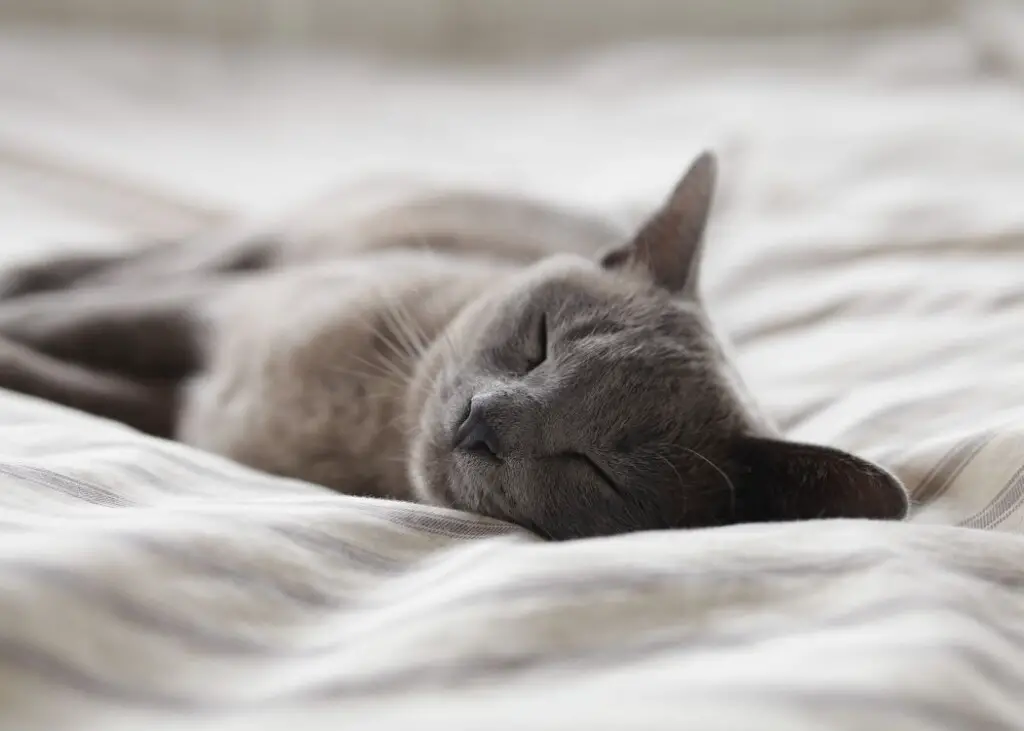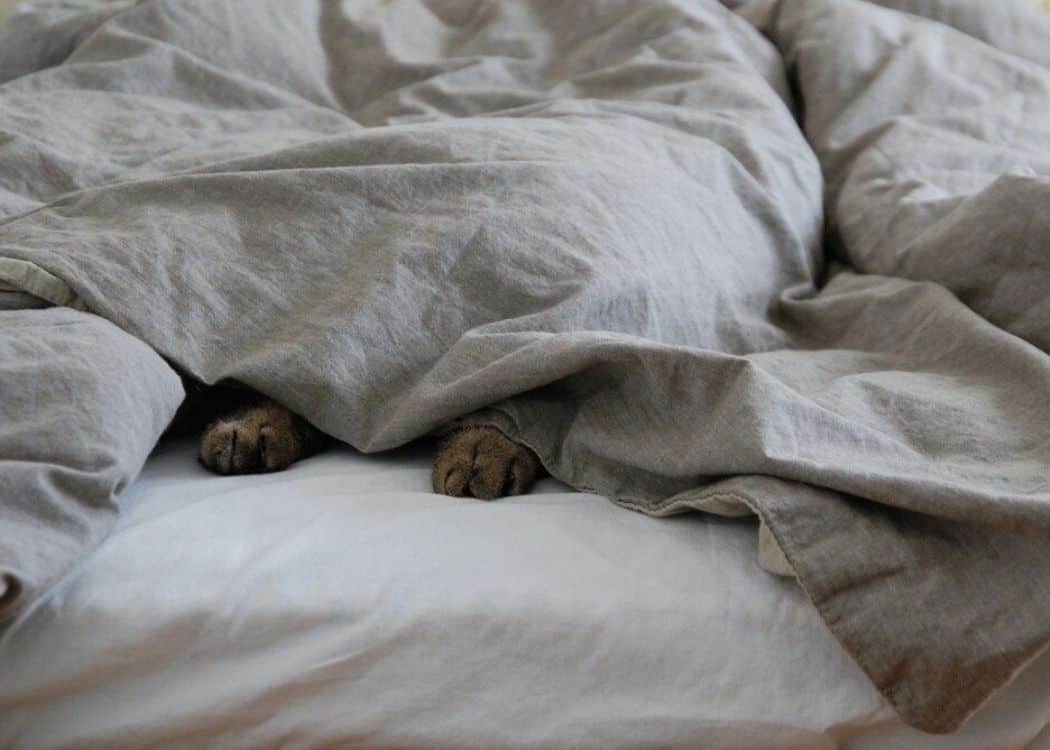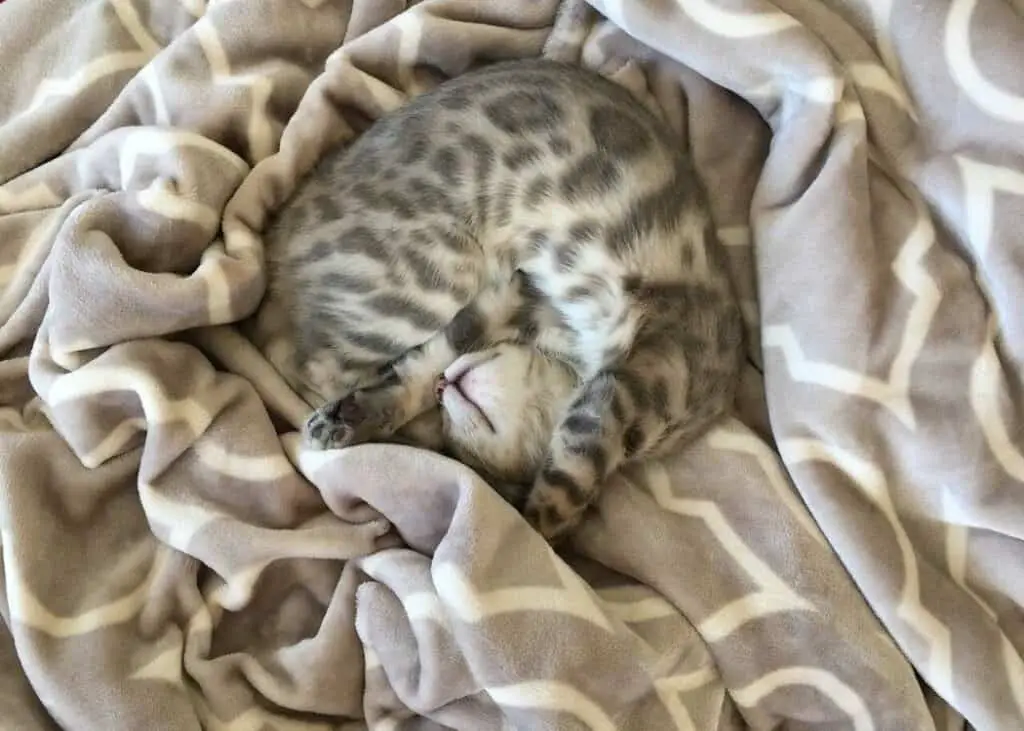Table of Contents
**This page contains affiliate links and I will be compensated if you make a purchase after clicking on my links**
Image by Jörn Heller from Pixabay
Either for medical reasons or simply old age, your beloved furry friend may have potty issues. These issues may be worse at night when you are less able to intervene.
If so, first make sure they are checked out by your veterinarian. Their inappropriate behavior may be their way of telling you something is wrong.
You have several options, but if you choose to let them stay with you in the bedroom, your choice of bedding is important.
Use bedding that includes a “waterproof” layer made of breathable polyurethane (PU)
Look for bedding sold as either “water-resistant”, or better yet, “waterproof”. These covers should contain a layer of polyurethane (PU).
Don’t worry, PU is nothing like the vinyl that was used in the mattress covers of old. Vinyl crinkled when you rolled over, and worse yet, didn’t breathe. You’d wake up in a puddle of sweat!
PU breathes. Bedding with this layer should “feel” no different than bedding without it.
Your “pet” isn’t the problem
Perhaps your pet isn’t the problem, but simply the scapegoat. Or perhaps you have no pets.
Humans also have incontinence issues, especially those on the young and old ends of the age spectrum.
Many of the solutions listed below will also work for humans.
And again. If this describes you or a family member, get yourself checked out first by a healthcare professional.
Protect your mattress
Of all the contents that make up your bed, you probably spent the most on your mattress. Likewise, you probably plan to keep it for several more years—at least a decade.
Mattress cover
Consider a protective mattress cover. These enclose your entire mattress and depending on how they are made, may protect from a variety of things:
- Stains and sweat
- Spills
- Bed bugs
- Dust mites
- Allergens, from dust mites, mold, or pets
Any protective cover is designed to capture stains and sweat. As mentioned, PU will capture the spills.
If the pore size of the fabric is small enough, it will also prevent dust mites and allergens from passing through into your mattress.
Note that some mattress covers are described as “encasements”, and some are not. Even though all mattress covers enclose your entire mattress, the top fabric may be different from the fabric on the sides and bottom.
In some covers, the fabric on the sides and bottom may be a mesh-like fabric. These “non-encasements” are designed to encourage breathability, however the mesh won’t block bed bugs.
True “encasements” have similar small-weave protective fabric on all sides. Nothing is getting past it.
Protective mattress covers are washable, however, getting them on and off the mattress is a chore. It’s best to put them on when you purchase the mattress and leave it at that.
But what if a canine, feline, or human occupant soils the bed?

Mattress pad
Add a protective mattress pad. What’s the difference? Mattress pads have a top and sides to fit the mattress, but unlike a cover, no bottom.
Because there’s no bottom, you can easily pull it off and throw it in the wash.
Mattress pads usually have a quilted top for added comfort. And like the mattress cover can be purchased as “waterproof” with an added layer of PU.
If you suffer from allergies (as I do) then use both a mattress cover and a mattress pad. However, if your concern is simply “spills” then the mattress pad alone may be enough.
(However, keep in mind that the sides of the mattress may still be at risk.)
If you don’t need a full mattress pad, smaller, less-expensive waterproof pads are also available. These don’t have sides but are simply a pad to place on the more “vulnerable” sections of your mattress, underneath your fitted sheet.
(Note when shopping, these are marketed for incontinent humans, rather than pets.)
Washable bedding
Working up from the mattress pad, everything you place on your bed should be machine washable. In hot water.
Put away that down comforter. Likewise, the wool bedding. And that fluffy duvet that doesn’t fit in your washing machine.
Pull out the old cotton sheets and the inexpensive polyester fleece blankets.
The less you care about it the better.
>> For more on how to wash bedding, see my post HERE.
Hot water will kill a lot of the germs (and the allergens), but for added disinfecting you may add oxygen bleach (like OxiClean™).
You may also add up to one-half cup of white vinegar during the rinse cycle.
Of note, even if you can no longer smell anything, your pet may still be able to smell traces of urine or feces, even on washed bedding. Because of this, they are likely to “mark” the spot again.
Protect the top of the bed
Stripping and washing all your bedding every time there’s an accident can get old fast.
Take steps to protect the top of your bed as well. This will be the first line of defense.
If spills get past this, you still have the bottom layers in place to prevent more damage.
Most pets have their favorite “spots” but still may switch things up.
Purchase a large waterproof blanket, or pad, to cover most of the bed
If looks aren’t important, a waterproof mattress pad (without the fitted sides), can also be used on top of the bed.
For something better looking, also check out pads designed to protect sofas. Some have extra material for sofa arms, but some are simply large squares to protect a futon, or similar.
You’ll need at least two blankets or pads. Maybe three. So, you can alternate with the one (or two) that will be in the laundry.
If accidents are a rare event you may stop there.
However, if you find yourself doing laundry every day, consider adding another layer of defense on top of this one.
This top layer can be composed of smaller, switchable—and more easily washed—sections. Consider the following:
- Large disposable “puppy pads”
- Old bath towels
- Smaller washable waterproof pads
Obviously, accidents can occur between the sections, even if you overlap them. Therefore, it’s important to have the one layer that covers your entire bed.
Keep an enzyme-based cleaner on hand
Most pet owners are familiar with enzyme-based cleaners, designed especially for pet messes. Nature’s Miracle® is probably the most well-known, with formulations for all kinds of issues.
Enzymes break up the protein that is part of the stain, along with their odors.
If the mattress itself has become soiled, one option is to pour enzyme-based cleaner on the area.
Yes, I said “pour”. Surface cleaning isn’t enough; the cleaner will need to penetrate as far down as the soiling goes.
Enzyme-based cleaners contain isopropyl alcohol and should dry relatively quickly. Obviously, let everything dry thoroughly before making up your bed.
Protect your floors
Carpet
Pets love throw rugs. They are great to nap on. And pee on.
If this is an issue, you may need to temporarily place the rug in storage. (Note, that if it has been soiled, the smell will linger and encourage marking by other pets in the future. It may need to go to a home free of pets.)
Wall-to-wall carpet is also at risk.
In addition to an enzyme-based cleaner, my go-to carpet cleaner is Spot-Shot®. Simply spray it on and the stain starts to disappear. A little scrubbing with a wet rag and it’s gone.
Works great for cat vomit, however, for soiling, I would probably start with an enzyme-based cleaner. Again, “pour” it on so that it soaks all the way through to the pad underneath.
For stubborn stains and odors, leave a wet towel on the area for an hour or two. This will slow the evaporation of the enzyme-based cleaner so that it has more time to work.
Tile
Yes, tile floors are ideal for pets.
If the worst happens you can simply drown the area in chlorine bleach without worrying about damaging your tile.
(This is for regular ceramic tile; tiles of natural stone such as marble or slate are another matter…)
However, has your grout been sealed? Or if it has been sealed, does it still prevent liquids—and the smells that come with those liquids—from penetrating the grout?
Remember, if the smell remains, your pet will simply re-pee in the same area.
Hardwood
Newer hardwood floors will be sealed with a protective polyurethane coating. Older floors with wax. Hopefully, you can catch the stain quickly… Cross-fingers.
The installer of my polyurethane-coated engineered hardwood floor informed me in no uncertain terms that I was to ONLY use a mild cleaner made by Bona®. It works great on cat vomit.
In the worst-case scenario, you may have to accept that your floors may either need to be replaced or refinished at a later date. As pet parents, we accept these things…

Restrict your pet to a crate or a small room that is easy to clean
It should be emphasized that this doesn’t work for cats. They do not like to be restricted, especially if they are separated from their favorite humans.
However, it’s fine for dogs. In fact, dogs like spending time in a crate, or a crate-like environment.
You can line the crate with puppy pads and your problem is solved.
Alternatively, you can line your bathroom with puppy pads as well. Just keep in mind that your bathroom tile is not impervious to the effects of soiling.
Diapers for pets
Again, doable for cats, but not recommended. Cats don’t like “clothing”, and will concentrate their efforts to remove any offending garments.
However, dog owners I know use this technique successfully for nighttime potty issues.
Note that pet diapers are different than human baby diapers; accommodation needs to be made for a tail.
Keep the litter boxes clean
Pets may potty in the wrong place simply because there is something wrong with their current potty.
Is your dog let out often enough? If they are older, they may need to be let out more often.
Likewise, is your cat’s litterbox relatively clean? It should be scooped regularly, and the litter replaced when its odor-canceling properties start to fade.
I’m a big fan of jumbo-sized disposable litter boxes. Throw the box out with the old litter. Done.
If you have more than one cat are there conflicts? Perhaps a cat is being prevented from “safely” using a litterbox? More boxes may need to be deployed in more locations.
Heated bedding for elderly pets
If your pet is elderly, there are other things you may do to increase their comfort. Elderly individuals suffer from arthritis.
Provide a heated pet bed, or simply place a heating pad in their bed underneath a towel.
Just as with all electric bedding, choose one with a safety auto-shutoff to prevent overheating, plus an auto-shutoff timer.
Alternatively, there are “self-heating” insulated pads made especially for keeping pets warm. These pads have a heat-reflecting layer that holds in the pet’s body heat.
This latter option—that doesn’t involve electric wiring—may be the best for your elderly incontinent pet.
As usual, purchase several as you may be washing them often…
Good luck!
Want to learn more about the products mentioned?
BONUS video: Don’t kick your incontinent pet out of bed
[If you experience issues with menus or links not working, it is most likely due to your Ad blocker.]



